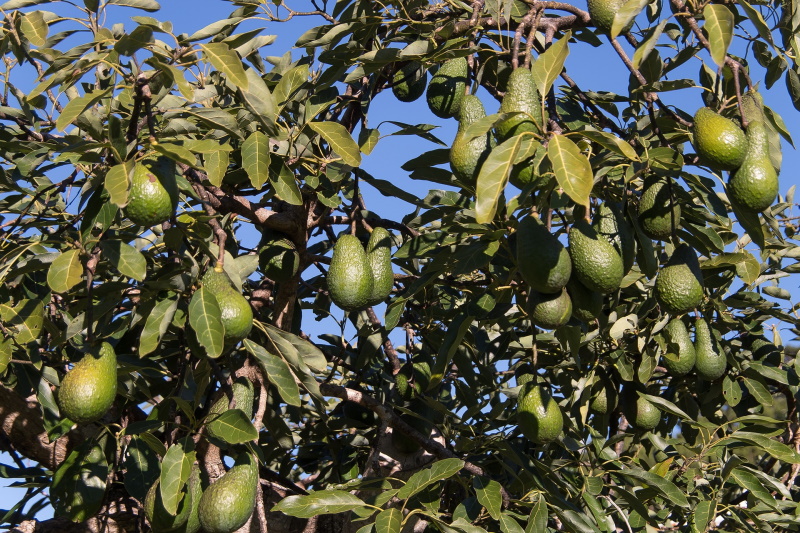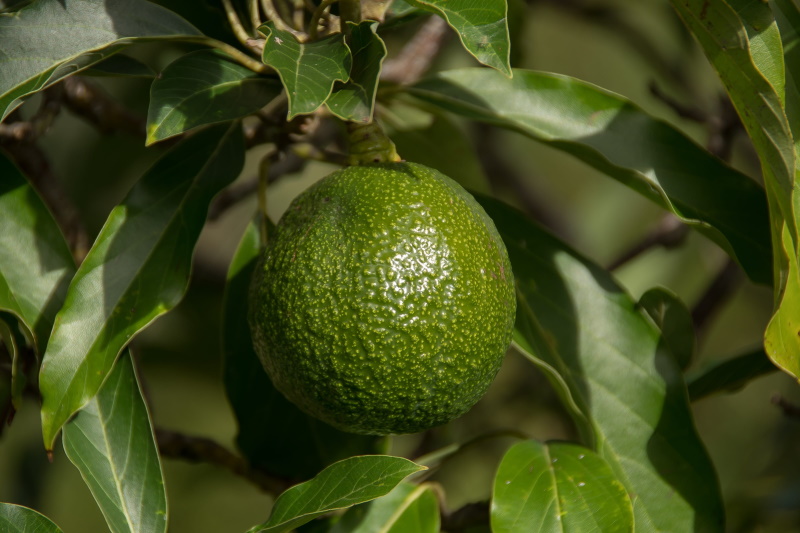15 Types Of Avocado Trees & Their Varieties (with Pictures)
-
Visnja Radosavljevic
- Last updated:

Avocado is a tasty tropical fruit that’s rich in nutrients and has various health benefits. Although many people buy avocados in stores, growing avocado trees in your yard is not complex.
There are many different avocado varieties, so it might be hard to select a species to grow, especially if you’re unfamiliar with all available avocado types. In this article, we will list 15 types of avocado trees, including both A and B avocado varieties.
Keep reading to learn more about them and their growing requirements.
The 9 A Avocado Varieties
1. Hass

| USDA Hardiness Region | 9–11 outdoors
4–11 indoors |
| Sun | Full sun/partial shade |
| Soil | Well-drained, sandy, loamy |
Hass is the most popular avocado variety in the US, distinctive due to its creamy flesh and taste. Depending on their placement, these trees can grow anywhere from 7 to 30 feet tall. Once you plant a Hass avocado, you can expect it to bear fruit after 2 or 3 years if you purchase a small tree, while it will take 5+ years to grow it from seed.
This avocado needs well-drained, preferably sandy or loamy soil and full sun or partial shade to prosper.
- Tasty fruits
- Can be grown both indoors and outdoors
- Easy to grow
- Growing from seed takes some time
2. Choquette
| USDA Hardiness Region | 9–10 |
| Sun | Full sun/partial shade |
| Soil | Acidic, well-drained |
Choquette is a self-fertilizing avocado variety that grows the best in Florida and California. These avocados prosper in full sun and partial shade, and they need acidic, well-drained soil to reach their full potential. They are typically around 30 feet tall, but you can keep them under 20 feet tall by pruning them regularly.
Choquette mostly bears large fruits, representing a perfect balance of quality and quantity. The fruits of this avocado are creamy and have a mild, nutty taste.
- Delicious flavor
- Not high maintenance
- Large fruits
- Can only be grown in warmer climates
3. Pinkerton
| USDA Hardiness Region | 8–10 |
| Sun | Full sun |
| Soil | Sandy, loamy, well-drained |
Pinkerton is a smaller avocado species, perfect for smaller gardens and yards. It typically grows around 20 to 30 feet and needs full sun to prosper. These avocados are not meant for container growing, so you’ll need to keep them outdoors. They are self-fertilizing when grown in colder climates but need pollinators in warm temperatures. Their fruits are pear-shaped and typically large, which can cause the branches to bend over. These avocados are easy to peel and have a slightly nutty taste.
- Smaller-sized tree
- Large fruit
- Self-fertilizing in colder climates
- Needs pollinators in warmer climates
- Large fruits can cause branches to bend
- Doesn’t grow well in containers
4. Reed

| USDA Hardiness Region | 8–11 |
| Sun | Full sun |
| Soil | Rich, loose, well-drained |
Reed avocado is similar to Hass avocado, but its fruits are larger and rounder. This variety is an excellent option for beginner growers as it requires little maintenance and is very productive. Compared to other avocado varieties, this tree grows tall and reaches about 37 feet. It needs full sun to prosper, and it grows best when you plant it in rich, well-drained soil. The fruits have a rich, nutty flavor but are hard to peel.
- Large fruits
- Requires little maintenance
- Rich flavor
- Fruits are difficult to peel
5. Lula
| USDA Hardiness Region | 9–12 |
| Sun | Full sun/partial shade |
| Soil | Well-drained, loamy |
Lula avocado variety originates from Florida and prefers sunny areas and well-drained, loamy soil. The fruits of this avocado are pear-shaped, with smooth skin. Unlike most avocado species, Lula can endure harsh weather, making it an excellent option for colder climates. It’s one of the hardiest varieties available and can tolerate temperatures below 28°F. These trees are smaller in size and can reach around 25 feet. Another great thing about Lula avocados is that they can produce fruits even without another tree, although pollination will promote fruit production.
- Hardy
- Withstands temperatures below 28°F
- Produces fruits without another tree
- Smaller size
6. Mexicola grande
| USDA Hardiness Region | 8–11 |
| Sun | Full sun/partial shade |
| Soil | Sandy, loamy, well-drained |
Mexicola grande is a cold-hardy variety that’s among the most frost-resistant avocado available. Its fruits have dark skin and taste creamy, with a rich nutty flavor. This avocado species can reach anywhere from 18 to 36 feet. It’s a hardy variety that can withstand temperatures below 17°F which most other avocado varieties can’t. They need full sun to partial shade and grow best in sandy or loamy soil that’s well-drained.
- Cold-hardy
- Front-resistant
- Nutty flavor
- Smaller fruits
7. Gwen
| USDA Hardiness Region | 8–10 |
| Sun | Full sun |
| Soil | Well-drained, moist |
Gwen is a dwarf-avocado variety, and it reaches only about 15 feet, which is much smaller than other species on the list. Although this species is not very popular, it has gained some fame in the last few years. Its fruits can be medium or large, and they have a buttery flavor with a nutty pinch. Although this avocado is productive, it’s intolerant to heat, cold, drought, and wind, so it can be challenging to grow it.
- Small
- Suitable for growing inside
- Capable of producing large fruits
- Intolerant to wind, drought, heat, and cold
8. Holiday
| USDA Hardiness Region | 9–11 |
| Sun | Full sun |
| Soil | Well-drained, rich, loamy, sandy |
The Holiday is a newer, highly productive dwarf avocado variety. It’s pretty frost-sensitive and reaches about 15 feet in height, making it an excellent option for residential use. You can keep this avocado smaller by practicing regular maintenance and pruning. This species is self-pollinating and will produce fruits 2 years after being planted.
They produce large, nut-flavored fruits that resemble the Hass variety. When growing them outdoors, choose a location with full sun, and if you’re growing them indoors, turn the plant to a south-facing window.
- Excellent for indoor growing
- Small size
- Self-pollinating
- Productive
- Frost-sensitive
9. Fantastic
| USDA Hardiness Region | 8–11 |
| Sun | Full sun/ partial shade |
| Soil | Well-drained, moist |
Fantastic is among the hardiest avocado species and can withstand temperatures as low as 15°F. They are low-maintenance and produce small, delicious fruits. The tree can grow pretty high, so it’s essential to prune it regularly to prevent overgrowth. This tree is typically around 30 feet high, however, you can keep up regular maintenance to keep it smaller. You should plant it in an area with full sun or partial shade for the best growth.
- Hardy
- Can withstand low temperatures
- Needs frequent maintenance and pruning
The 6 B Avocado Varieties
10. Bacon
| USDA Hardiness Region | 8–11 |
| Sun | Full sun |
| Soil | Loamy, fast-draining |
Bacon avocado is the first B-type avocado variety on our list. This species is self-fertile in colder climates, reaching 25 to 35 feet once mature. They prefer locations with full sun, and they need loamy, fast-draining soil to prosper. The fruits have a round, slightly elongated shape and are mild in taste. A downside to this avocado is its ruthless root systems that can choke all nearby plants.
- Self-fertile in colder climates
- Delicious fruit
- Roots can choke nearby plants
11. Sharwil
| USDA Hardiness Region | 9–11 |
| Sun | Full sun |
| Soil | Well-drained, organic |
Sharwil is an avocado species that consistently bears fruit, although it’s smaller than some of the other avocado varieties. It typically reaches between 18 and 35 feet and bears pear-shaped fruits with rough skin. They are very sensitive to frost, so they’re not suitable for growing in cooler climates. It requires a position with full sun, and you’ll need to frequently fertilize the area with organic matter because of the soil requirements.
- Consistently bears fruit
- Sensitive to frost
- Needs frequent fertilizing
12. Fuerte
| USDA Hardiness Region | 9–11 |
| Sun | Full sun |
| Soil | Sandy, well-drained |
Fuerte is an avocado variety that produces high-quality, pear-shaped fruits with a slight hazelnut flavor. It’s a large spreading tree, and it can be anywhere from 18 to 36 feet tall. This avocado tree usually needs a lot of space, so it’s not the perfect option for smaller yards. They are not suitable for colder climates, and you should plant them in areas that have an optimal temperature between 60°F and 80°F.
- High-quality fruits
- Not suitable for small spaces
- Not suitable for colder climates
13. Zutano
| USDA Hardiness Region | 8–11 |
| Sun | Full sun/partial shade |
| Soil | Moist, well-drained, loamy, sandy |
Zutano avocado is a rare species, and many people use it to pollinate other avocado varieties they grow. This tree can reach anywhere from 40 to 50 feet, and it’s a cold-hardy variety that can withstand lower temperatures. The fruits have a pear-like shape and glossy skin, while their taste resembles the Fuerte avocado. These avocados are not too popular commercially as they have a mild flavor and a green color when ripe.
- Excellent pollinator
- Cold-hardy
- Not commercially popular
- Mild flavor
14. Cleopatra
| USDA Hardiness Region | 8–11 |
| Sun | Full sun |
| Soil | Well-drained, rich |
Cleopatra is a smaller avocado variety that bears medium-dark fruits that have a rich nutty flavor. Although these trees only grow to a small size, they form a thick canopy that will provide excellent shade to your yard. This variety can be self-pollinating, but it will bear more fruits if you mix it with another species such as Hass. Typically, this avocado variety needs full sun, well-drained, rich soil, and it will be harvest-ready from July to December.
- Forms a thick canopy
- Can be self-pollinating
- Needs a pollinator to bear more fruits
15. Winter Mexican
| USDA Hardiness Region | 8–11 |
| Sun | Full sun/partial shade |
| Soil | Sandy, loamy, well-drained |
Winter Mexican is a hardy avocado species that’s a hybrid between Mexican and Guatemalan avocado varieties. A great thing about this variety is that it’s tolerant to both heat and cold, so it’s an excellent option for both indoor and outdoor growing. These trees typically reach a height of up to 40 feet, but you can prune them regularly to make them smaller in size. Their fruits are dark-skinned, and they contain a rich, nutty taste that many people love.
- Heat and cold tolerant
- Great for indoor and outdoor growing
- Needs pruning to remain small in size
Conclusion
There are many different available avocado species, so it’s up to you to decide which one works best for your needs. We suggest checking the list above one more time to determine which variety would be the option for you. As long as you provide the tree with all the needed growing requirements, you’ll be able to enjoy delicious avocados only a few years after planting.
Featured Image Credit: sandid, Pixabay
Contents
